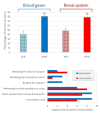Tunes in the Zoom Room: Remote Learning via Videoconference Discussions of Physiology Songs
- PMID: 33884097
- PMCID: PMC8046665
- DOI: 10.1128/jmbe.v22i1.2529
Tunes in the Zoom Room: Remote Learning via Videoconference Discussions of Physiology Songs
Abstract
As most instruction has been forced online, biology instructors have become acutely aware of the many advantages and limitations of online teaching. Here, we investigate one possible advantage of online education: the ease of allowing remote guest speakers to interact with students in real time. In particular, we piloted a model in which guest speakers could facilitate direct music-related interactions with students, possibly benefiting students' content knowledge and sense of community. In the context of an undergraduate animal physiology course, face-to-face lessons on arterial blood gases and the renal system were supplemented with videoconferences with a guest speaker who presented relevant content-rich songs and led class discussions of the lyrics. Survey and test data suggested that, after each of the lessons, the students (i) had increased confidence in their understanding of the material, (ii) performed better on objective test questions, and (iii) attributed their learning chiefly to the musical intervention. While our approach awaits further exploration and testing, this report provides preliminary evidence of its feasibility and offers practical suggestions for others who may wish to give it a try.
©2021 Author(s). Published by the American Society for Microbiology.
Figures


Similar articles
-
Using science songs to enhance learning: an interdisciplinary approach.CBE Life Sci Educ. 2012 Spring;11(1):26-30. doi: 10.1187/cbe.11-08-0068. CBE Life Sci Educ. 2012. PMID: 22383614 Free PMC article. Review.
-
Student and educator experiences of maternal-child simulation-based learning: a systematic review of qualitative evidence protocol.JBI Database System Rev Implement Rep. 2015 Jan;13(1):14-26. doi: 10.11124/jbisrir-2015-1694. JBI Database System Rev Implement Rep. 2015. PMID: 26447004
-
Exploring the Impact of Technology Use with Cosmetic Science Guest-Speakers: A Qualitative Study.Innov Pharm. 2019 Aug 31;10(2):10.24926/iip.v10i2.1604. doi: 10.24926/iip.v10i2.1604. eCollection 2019. Innov Pharm. 2019. PMID: 34007548 Free PMC article.
-
Is memorization the name of the game? Undergraduates' perceptions of the usefulness of physiology songs.Adv Physiol Educ. 2020 Mar 1;44(1):104-112. doi: 10.1152/advan.00112.2019. Adv Physiol Educ. 2020. PMID: 32057265
-
Teaching science with the "universal language" of music: alignment with the Universal Design for Learning framework.Adv Physiol Educ. 2023 Sep 1;47(3):491-498. doi: 10.1152/advan.00006.2023. Epub 2023 Apr 27. Adv Physiol Educ. 2023. PMID: 37102712 Review.
References
-
- MacLeod J, Yang HH, Shi Y. Student-to-student connectedness in higher education: a systematic literature review. J Comput High Educ. 2019;31(2):426–448. doi: 10.1007/s12528-019-09214-1. - DOI
-
- Means B, Neisler J. Suddenly online: a national survey of undergraduates during the COVID-19 pandemic. Digital Promise; Washington, DC: 2020.
-
- Elliott D, Gamino M, Jenkins JJ. Creating community in the college classroom: best practices for increased student success. Int J Educ Soc Sci. 2016;3(6):29–41.
-
- Birt JA, Siegel MA. Reaching rural students: CARE principles to promote student engagement in college biology courses. Am Biol Teach. 2020;82(1):11–17. doi: 10.1525/abt.2020.82.1.11. - DOI
-
- Hagay G, Baram-Tsabari A. A strategy for incorporating students’ interests into the high-school science classroom. J Res Sci Teach. 2015;52(7):949–978. doi: 10.1002/tea.21228. - DOI
LinkOut - more resources
Full Text Sources
Other Literature Sources
Research Materials

